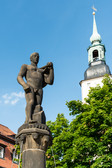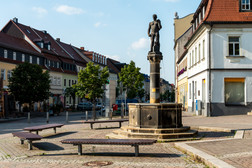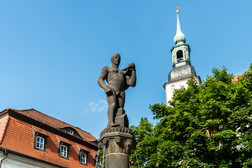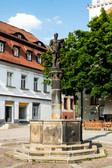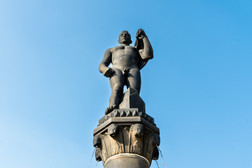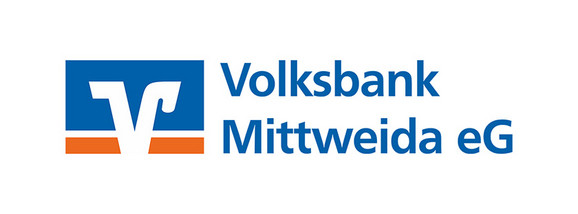Arthur Heinrich Lippert: Arbeit unser Segen Quell
Frankenberg
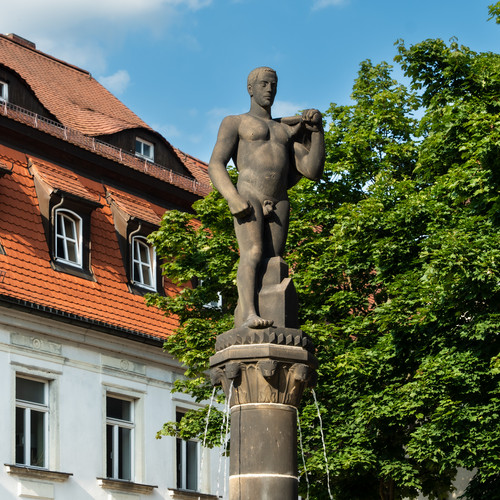
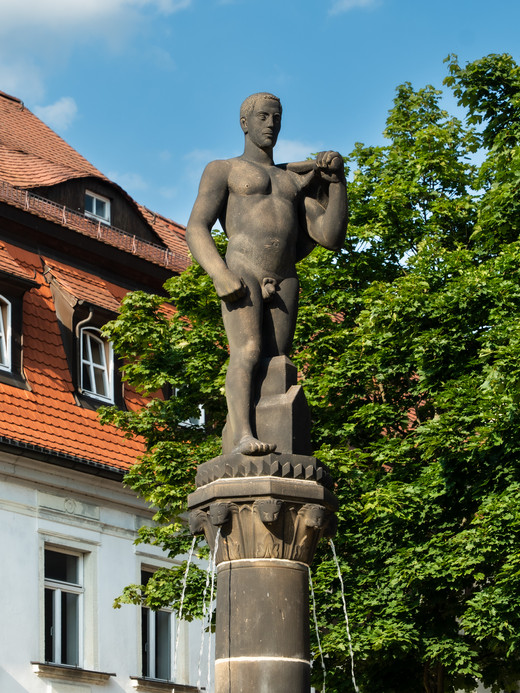
On a central, tall column in the basin of the Octagon Fountain on Frankenberg's market square stands a stylised figure of a naked man holding a hammer on his left shoulder, draped in lightly pleated fabric. A model house can be seen between the figure's legs and below its knees. Narrow streams of water flow from the column capital, which serves as the figure's pedestal. The powerful, expressionist representation, enhanced by the black-patinated Posta sandstone, was intended to reflect the working ideal of the German Empire, according to the plans of the Saxon Art Fund, which financed the sculpture. However, the project, which was to be implemented as early as 1914 at the suggestion of the Dresden Academic Council by the sculptor Arthur Heinrich Lippert, was delayed. This was because the artist Lippert, who was born in Waldheim in 1879 as the son of a chair maker and completed his master's degree at the Dresden Art Academy under the fountain sculptor Robert Diez, with whom Ernst Barlach also studied, was drafted as a soldier in the First World War at the beginning of the war in 1914. He continued to plan his sculpture for Frankenberg from the front. The hyperinflation that began in 1920 in the young Weimar Republic almost caused the project to fail again. Several appeals published in the Frankenberger Tageblatt in April 1921 raised the missing funds in a kind of municipal crowdfunding campaign, so that Lippert's work could finally be ceremoniously inaugurated on 7 August 1921.
Lippert's allegory of work survived all the divergent political systems of the 20th century, regardless of its creator's original artistic intention. While the people of Frankenberg in the 1920s saw the ‘Nakschen Mann’, as the fountain sculpture is popularly known, as a symbol of the powerful reconstruction after the end of the First World War, interpretations shifted under Nazi rule in the 1930s and 1940s to a symbol of nationalist work ideology. Lippert's work also seemed to fit in with the artistic understanding of Socialist Realism in the early GDR and its postulates of closeness to the people, partisanship and comprehensibility. After its restoration, the sculpture, which today has become the ideologically uncontested landmark of the city of Frankenberg, became part of the Purple Path: as an early testimony to communal-collective patronage and as a symbol of the shift in the interpretation of art in public space during the transition of political systems, as well as the centre of the ‘Skulpturenpfad Frankenberg/Sa.’ (Frankenberg/Sa. Sculpture Trail) initiated by the local art and culture association, featuring contemporary art.
(Text: Alexander Ochs / Ulrike Pennewitz)
With the kind support of Volksbank Mittweida eG
